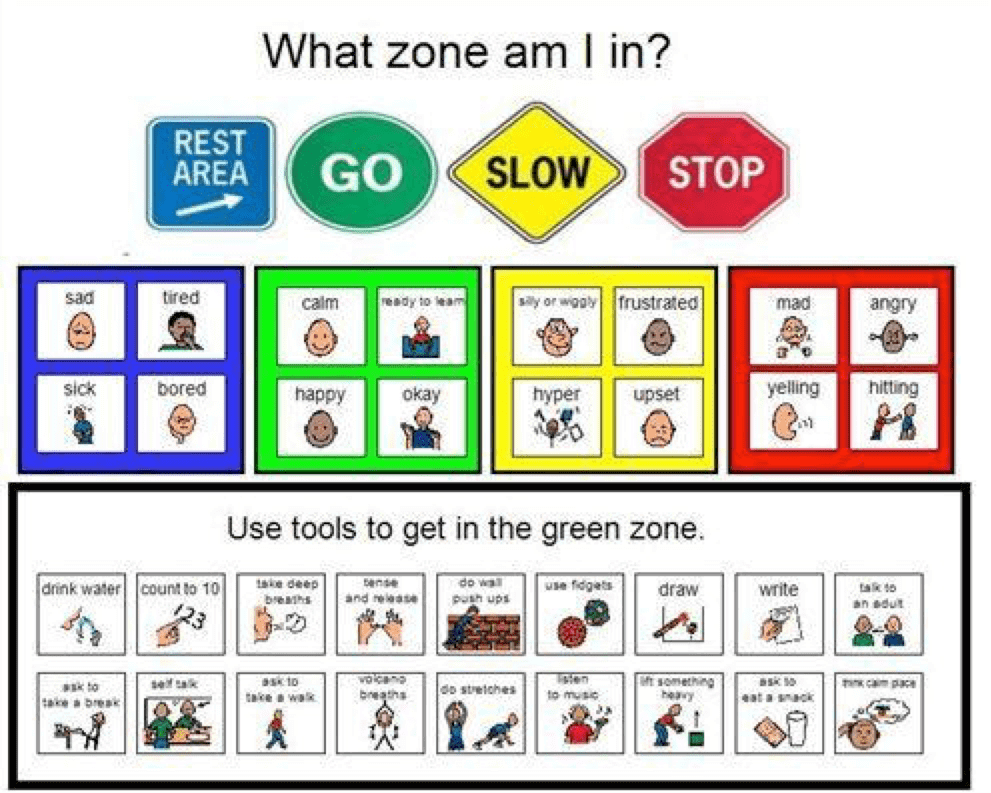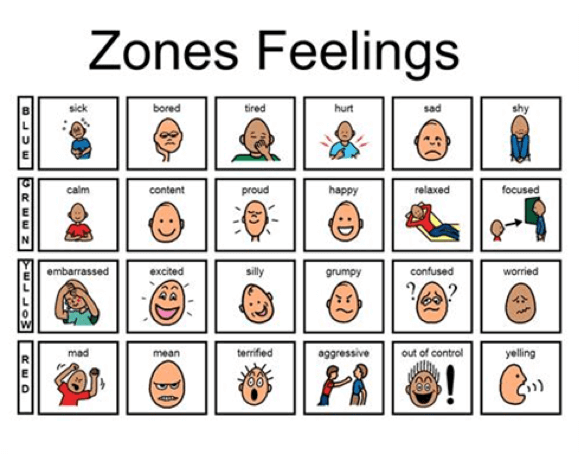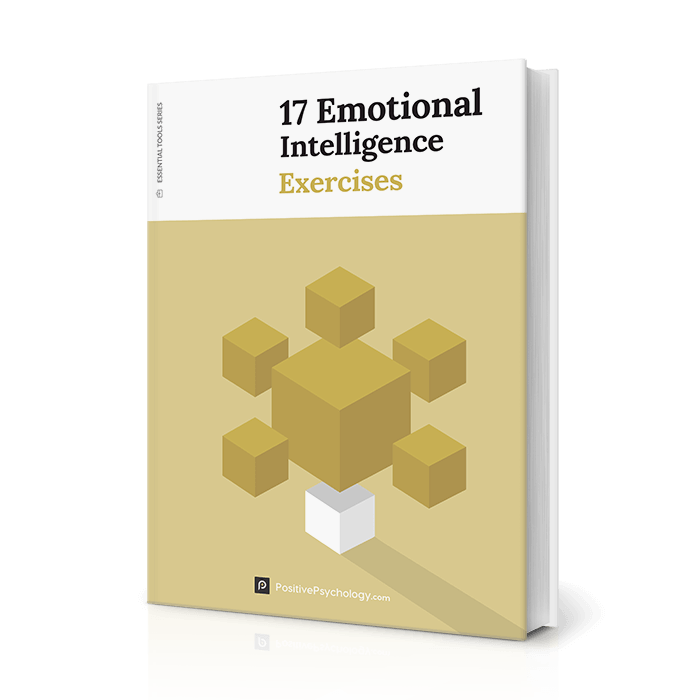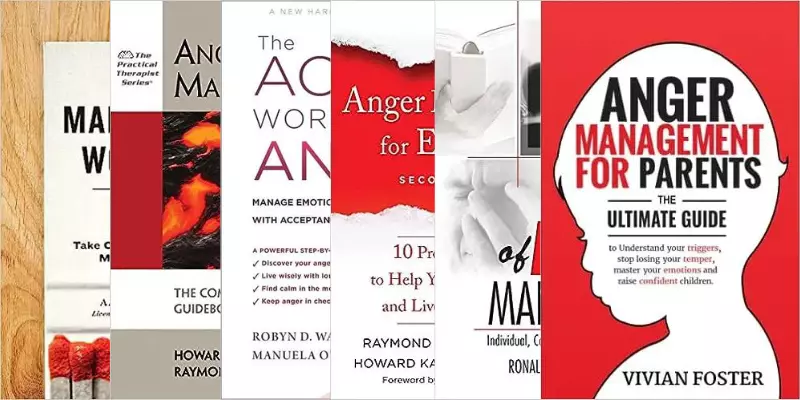21 Emotion Regulation Worksheets & Strategies
 As humans, we will never have complete control over what we feel, but we have a lot more influence over how we feel than you might have heard.
As humans, we will never have complete control over what we feel, but we have a lot more influence over how we feel than you might have heard.
The skills that allow you to manage and direct your emotions are called emotion regulation skills (see self-regulation), and it doesn’t take a pilgrimage to a holy site or thousands of dollars to learn these secrets to feeling better.
This article will see you learn about emotion regulation and help you develop and improve the skills necessary for staying balanced and emotionally stable.
Before you read on, we thought you might like to download our three Emotional Intelligence Exercises for free. These science-based exercises will not only enhance your ability to understand and regulate your emotions but will also give you the tools to foster the emotional intelligence of your clients, students or employees.
This Article Contains:
An Explanation of Emotion Regulation in Dialectical Behavior Therapy
Emotion regulation is one of the four skills modules of Dialectical Behavior Therapy or DBT. These four modules include:
- Interpersonal effectiveness;
- Distress tolerance/reality acceptance skills;
- Emotion regulation;
- Mindfulness skills.
The emotion regulation portion focuses on skills that benefit everyone who has emotions (i.e., every human!), but they are most beneficial for those struggling with mood or personality disorders, especially those with Borderline Personality Disorder (BPD).
In this module, clients learn how to understand and accept their emotions, reduce their emotional vulnerability and volatility, and decrease their emotional suffering (Bray, 2013).
One of the most important aspects of treatment is recognizing that negative or painful emotions are not inherently bad. Clients are encouraged to accept that they will undoubtedly experience negative emotions in their life, no matter how happy or well-balanced they may be.
Instead of focusing on avoiding or denying the presence of the negative, DBT clients learn valuable skills to keep their emotions in check and avoid emotional dysregulation.
What Is Emotional Dysregulation?

If emotion regulation is the process of controlling one’s emotions, keeping them in balance and away from extremes, then it’s probably easy to figure out what emotional dysregulation is—the inability to control one’s emotional responses.
Emotional dysregulation is a process with three main steps:
- An internal or external event (thinking about something sad or encountering someone who is angry) provokes a subjective experience (emotion or feeling);
- Then a cognitive response (thought) is followed by an emotion-related physiological response (for example, an increase in heart rate or hormonal secretion);
- The process culminates in a behavior (avoidance, physical action, or expression; PCH Treatment Center, n.d.).
People who are struggling with emotional dysregulation react to relatively mild negative events in an emotionally exaggerated manner; they may cry, scream, accuse, or blame those around them, or engage in passive-aggressive behaviors or other behaviors that can disrupt relationships and escalate conflict (PCH Treatment Center, n.d.).
Recent research has proposed that emotional dysregulation, especially when present in those suffering from BPD, is made up of four components:
- Emotion sensitivity;
- Heightened and unstable mood or emotions;
- A lack of appropriate emotion regulation strategies;
- A plethora of maladaptive emotion regulation strategies (Carpenter & Trull, 2013).
DBT Self Help: 3 Emotion Regulation Questionnaires
There are a few different self-assessment tools available to learn about your own emotion regulation abilities. The three most popular and most evidence-backed scales are included below.
Emotion Regulation Questionnaire
The Emotion Regulation Questionnaire, or ERQ, is the most popular emotion regulation scale among psychology researchers. It was developed in 2003 by James Gross and John Oliver, based on five studies spanning the question development, validity and reliability, and structure of the questionnaire.
The scale is composed of 10 items, rated on a scale from 1 (strongly disagree) to 7 (strongly agree). The scale covers two facets, the Cognitive Reappraisal facet and the Expressive Suppression facet, and produces a separate score for each facet.
The six items that make up the Cognitive Reappraisal facet are as follows:
- When I want to feel more positive emotion (such as joy or amusement), I change what I’m thinking about;
- When I want to feel less negative emotion (such as sadness or anger), I change what I’m thinking about;
- When I’m faced with a stressful situation, I make myself think about it in a way that helps me stay calm;
- When I want to feel more positive emotion, I change the way I’m thinking about the situation;
- I control my emotions by changing the way I think about the situation I’m in;
- When I want to feel less negative emotion, I change the way I’m thinking about the situation.
The four items that make up the Expressive Suppression facet include;
- I keep my emotions to myself;
- When I am feeling positive emotions, I am careful not to express them;
- I control my emotions by not expressing them;
- When I am feeling negative emotions, I make sure not to express them.
For more information on using this scale, click here.
Interpersonal Emotion Regulation Questionnaire
The Interpersonal Emotion Regulation Questionnaire, or IERQ, was developed to focus on the less attended interpersonal emotion regulation processes, rather than interpersonal processes. This scale was developed very recently (2016) by researchers Hofmann, Carpenter, and Curtiss.
It consists of 20 items and covers four factors, each containing five items rated on a scale from 1 (not true for me at all) to 5 (extremely true for me).
The four factors and their associated items are as follows:
- Enhancing Positive Affect:
o I like being around others when I’m excited to share my joy;
o Being in the presence of certain other people feels good when I’m elated;
o I like being in the presence of others when I feel positive because it magnifies the good feeling;
o Because happiness is contagious, I seek out other people when I’m happy;
o When I feel elated, I seek out other people to make them happy. - Perspective Taking:
o It helps me deal with my depressed mood when others point out that things aren’t as bad as they seem;
o Having people remind me that others are worse off helps me when I’m upset;
o When I am upset, others make me feel better by making me realize that things could be a lot worse;
o When I am annoyed, others can soothe me by telling me not to worry;
o Having people telling me not to worry can calm me down when I am anxious. - Soothing:
o I look for other people to offer me compassion when I’m upset;
o Feeling upset often causes me to seek out others who will express sympathy;
o I look to others for comfort when I feel upset;
o I look to other people when I feel depressed just to know that I am loved;
o When I feel sad, I seek out others for consolation. - Social Modeling:
o It makes me feel better to learn how others dealt with their emotions;
o Hearing another person’s thoughts on how to handle things helps me when I am worried;
o Seeing how others would handle the same situation helps me when I am frustrated;
o When I’m sad, it helps me to hear how others have dealt with similar feelings;
o If I’m upset, I like knowing what other people would do if they were in my situation.
This scale produces four scores, one for each subscale, and they are calculated by simply adding up the score for each item. Each subscale has a minimum score of 5 and a maximum score of 25.
Click here to learn more about the IERQ.
Cognitive Emotion Regulation Questionnaire
The Cognitive Emotion Regulation Questionnaire, or CERQ, is a scale for identifying the cognitive coping strategies used after a negative experience (Garnefski, Kraaij, & Spinhoven, 2001). It differs from other emotional regulation questionnaires in its focus on the individual’s thoughts and exclusion of the behavior; it aims to find out what cognitive strategies the individual uses, rather than how they behave.
The scale is composed of 36 items rated on a scale from 1 ([almost] never) to 5 ([almost] always). It includes nine separate cognitive coping strategies, with four items comprising each strategy.
The nine strategies and an example item are included below:
- Self-blame – I feel that I am the one who is responsible for what has happened;
- Acceptance – I think that I have to accept that this has happened;
- Rumination – I want to understand why I feel the way I do about what I have experienced;
- Positive Refocusing – I think of pleasant things that have nothing to do with it;
- Refocus on Planning – I think about how I can best cope with the situation;
- Positive Reappraisal – I think that I can become a stronger person as a result of what has happened;
- Putting into Perspective – I think that it hasn’t been too bad compared to other things;
- Catastrophizing – I often think that what I have experienced is much worse than what others have experienced;
- Other-blame – I think about the mistakes others have made in this matter.
10 DBT Emotion Regulation Strategies & Techniques
 One of the best things about DBT is its focus on practical, real-world skills and techniques.
One of the best things about DBT is its focus on practical, real-world skills and techniques.
In this form of therapy, you won’t have to worry about vague ideas surrounding healing and moving forward; your therapist will have a detailed list of skills, strategies, and techniques you can use to start feeling and doing better.
A few of the best strategies and techniques are discussed below.
Understanding and Labelling Emotions
One of the most powerful tools in emotion regulation is simply identifying and naming the emotion you are feeling.
DBT encourages clients to use descriptive labels for their feelings rather than vague or general terms. The idea behind this skill is that to manage an emotion, you must first know what it is.
Clients of DBT will also learn about the difference between primary and secondary emotions, and how to address each in the most helpful way.
Primary emotions: the initial reaction to an event or to triggers in your environment.
Secondary emotions: the reaction to your primary emotions or thoughts (Bray, 2013).
Primary emotions are often completely natural reactions to things around us, like being sad when a loved one dies, or angry when someone is rude to us. However, secondary emotions are more dangerous and more within our control; we generally have more of a choice about how to respond to the fact that we are sad when someone dies.
Secondary emotions can push us towards behaviors that are destructive and maladaptive, making it essential to learn how to accept your primary emotion without judging yourself for feeling it.
In DBT sessions, you may also discuss myths surrounding emotions, such as the idea that there is a “right” and a “wrong” way to feel about certain events or situations. Our emotions are unique, organic experiences that cannot be molded to fit ideas of what is “normal,” and to try can be harmful.
In fact, emotions are adaptive evolutionary traits—they developed because they helped us function better, both by helping us communicate with others and by alerting us to things in our environment that are beneficial or potentially problematic (Bray, 2013).
Learning to better understand, recognize, and label emotions is an enormously helpful skill to have, and not only will it give you a good foundation for managing your emotions, but it will also help you understand and empathize with others.
Mindfulness
Mindfulness can be described as living your life in the present instead of being stuck in the past or the future (Tartakovsky, 2015). Practicing mindfulness helps us become more aware of our thought patterns, our emotions, and how our thoughts and feelings affect our reactions to events.
There are two categories of mindfulness skills: “What” skills and “How” skills:
- “What” skills:
o Observe;
o Describe;
o Participate. - “How” skills:
o Non-judgmentally;
o One-mindfully;
o Effectively (Dietz, 2012).
If you’re interested in learning more about how to practice mindfulness, check out our post on mindfulness exercises and techniques here.
Letting Go of Painful Emotions
 Perhaps the most important emotion regulation skill, learning to let go can be very difficult but is worth the effort you invest.
Perhaps the most important emotion regulation skill, learning to let go can be very difficult but is worth the effort you invest.
Humans have a tendency to become stuck when attempting to process negative emotions. Instead of simply letting them go, we often hold ever tighter to them, obsessing over every little bit of our emotional experience and wondering why it’s happening to us.
It sounds paradoxical, but the act of accepting that we are feeling emotions we would rather not feel can be the key to letting go of them. When we accept that we are suffering, we stop running from the difficult emotions and turn to face them—and when we do, we might see that it wasn’t the big bad monster we thought it was, but a smaller and more manageable beast.
Follow these steps to work on your ability to let go of negative emotions:
- Observe your emotion. Acknowledge that it exists, stand back from it, and get yourself unstuck from it;
- Try to experience your emotion as a wave, coming and going. You may find it helpful to concentrate on some part of the emotion, like how your body is feeling or some image about it. For example, you could use this imagery:
“Try to imagine an ocean wave flowing through you, but not so big that it knocks you over. Don’t try to push the emotion away. This makes it bigger and increases our suffering. Don’t reject the emotion. Don’t judge your emotion. It is not good or bad. It is just there. There are no bad emotions, just emotions. Anger, fear, sadness are all painful emotions, but they are not bad.
Everyone has them, and they are just as valid as the happy emotions. At the same time, do not hang on to your emotion. Don’t rehearse it over and over to yourself. Don’t escalate it or make it bigger. Sometimes when we feel a very painful emotion, like anger or a deep grief, we hold on to it, or we intensify it, making it stronger and stronger, in our efforts to deal with it or to give it our full attention. Try not to do this. Just let it be however it is. This can result in a lessening of the pain.”
- Recognize that you are not your emotion. Your emotion is part of you, but it is not all of you. You are more than your emotion;
- Do not necessarily act on the emotion; having the emotion does not mean that you have to act. You may just need to sit with the emotion. Often, acting can intensify and prolong the emotion;
- Practice LOVING your emotions. This can be a difficult concept. Why would we want to love painful emotions?
We can learn to love our emotions just the way we can learn to love (accept) anything else about ourselves or our experience that we cannot change—our age, our height, freckles, the birds that sing early in the morning and wake us up, the weather, the size of our feet, allergies, etc.
Remember that acceptance (love) and approval are two different things. You don’t have to like your freckles, but they are there and you can’t change that, so if you just accept or love them, you will feel a lot better than if you keep fighting the idea that they are there (Dietz, 2012).
Emotion Regulation Tips for the Holidays
With the holidays coming up, you might be visiting with family you don’t see in everyday life. These get-togethers can be great opportunities to reconnect with loved ones, but they can also be stressful and emotionally charged.
Follow these DBT self-help tips to get through your holiday visits with dignity and grace (Dietz, 2012).
Take Care of Your Body
To have a healthy mind, it’s extremely helpful to start with a healthy body. Take care of yourself by eating healthy meals, exercising regularly, getting enough sleep, avoiding toxic or mood-altering substances, and treating any illnesses or issues that require treatment.
We don’t make the best decisions when we are feeling sick, tired, or hungry, so eliminating these physical issues will make it easier for you to maintain your emotional balance.
Increasing Positive Emotions
Focus on increasing your positive emotions during the holiday season. You shouldn’t ignore your negative emotions, but make sure to leave room for the positive as well.
Find Ways to Have Fun
This one is self-explanatory—give yourself permission and the opportunities to enjoy yourself during the holidays.
Work on Relationships
Holiday gatherings are a great opportunity to repair and restart relationships with friends that you haven’t seen in a while. Leave yourself open to the possibility of renewing old friendships, as well as to forging new friendships.
Perhaps most important of all, commit to maintaining and strengthening your current relationships with family, friends, and anyone else you are likely to see on your holiday travels.
Be Present to and Mindful of the Positive
Focus on the good things that your holiday season has brought you, such as seeing an old friend, getting a present that you’re really excited about, or attending a fun New Year’s Eve party. Even if bad things happen, there’s bound to be at least one or two positive things to savor.
Be Unmindful of Worries
While you’re focusing on the positive, it will make the next suggestion easier to implement: putting your worries and insecurities aside. Crowd out the negative in your head with all the positive that you can find. Remind yourself that you deserve to have fun, to enjoy your time with friends, and to bask in the warmth of a loving family. Make room in your mind for the positive, and the negative will have less space to fill (Dietz, 2012).
STOPP
If you’re struggling with controlling your emotions, consider how to STOPP (Vivyan, 2015).
STOPP is a strategy that will help you in the heat of the moment when you are dealing with intense emotions. It incorporates aspects of Cognitive Behavioral Therapy (CBT), DBT, and mindfulness meditation to help you more effectively address and manage your emotional response to a challenging, difficult, or rage-inducing incident.
STOPP stands for:
- S – Stop!
o Just pause for a moment. - T – Take a Breath
o Notice your breathing as you breathe in and out. - O – Observe
o What thoughts are going through your mind right now?
o Where is your focus of attention?
o What are you reacting to?
o What sensations do you notice in your body? - P – Pull Back – Put in Some Perspective
o What’s the bigger picture?
o Take the helicopter view;
o What is another way of looking at this situation?
o What would a trusted friend say to me right now?
o Is this thought a fact or an opinion?
o What is a more reasonable explanation?
o How important is this? How important will it be in 6 months’ time? - P – Practice What Works – Proceed
o What is the best thing to do right now? For me? For others? For the situation?
o What can I do that fits with my values?
o Do what will be effective and appropriate (Vivyan, 2015).
If you learn only one skill that will help you to more effectively regulate your emotions, this should be the one you learn. Learning how to pause in between an intense emotional reaction and your ensuing actions is one of the most valuable and life-changing skills that a person can have. Practice STOPPing, and you will be in a great position to manage your most difficult emotions.
Differentiating Between Healthy and Unhealthy Emotion Regulation Activities
 There are many techniques to help you steer your emotions in the right direction, or to maintain your positive mood and emotional balance.
There are many techniques to help you steer your emotions in the right direction, or to maintain your positive mood and emotional balance.
There are also many techniques that on the surface seem like they will help you keep your emotional balance but upon further consideration reveal themselves to be unhealthy.
Different activities might work best for you, but these lists are a good start if you are unsure where to begin separating healthy from unhealthy activities.
Healthy activities that help you regulate your emotions include:
- Talking with friends;
- Exercising;
- Writing in a journal;
- Meditation;
- Therapy;
- Taking care of yourself when physically ill;
- Getting adequate sleep;
- Paying attention to negative thoughts that occur before or after strong emotions;
- Noticing when you need a break—and taking it!
These activities are healthy because they not only contribute to better management of your emotions, they do not cause you any harm.
Unhealthy activities that may seem like they help, but actually hurt, include:
- Abusing alcohol or other substances;
- Self-injury;
- Avoiding or withdrawing from difficult situations;
- Physical or verbal aggression;
- Excessive social media use, to the exclusion of other responsibilities (Rolston & Lloyd-Richardson, n.d.).
These activities tend to feel good and help in the moment, as well as provide a better strategy than “total avoidance” of situations that you inevitably will have to face.
When you are tempted to engage in an unhealthy activity, consider an activity that builds a sense of achievement instead. Try an activity that will result in you learning something new or developing a new skill, and allow yourself the space to build on it every day.
Doing something positive and fulfilling like this can not only increase your skills and boost your positive emotions but will also leave less room for negative emotions (Rolston & Lloyd-Richardson, n.d.).
3 Ways you can improve emotional regulation using DBT
8 Emotional Regulation Worksheets & Emotion Pictures
Aside from the strategies and techniques listed above, there are also several helpful handouts, worksheets, and even images that can aid you in developing your DBT skills and improving your emotion regulation.
Below are eight of the best worksheets, handouts, and emotion pictures available.
Practicing Radical Acceptance
This worksheet helps you to identify and understand a situation or emotion you are struggling to accept.
First, you identify your context; “What is the challenge or situation?”
Next, you describe the aspect of this situation that is difficult for you to accept.
Then you describe the reality of that situation.
After describing the reality, it asks you to think about the antecedents – or causes – that came before that reality (hint: many of them you will find to be outside of your control).
Next, you practice radical acceptance with your whole being (mentally, physically, and spiritually), describing how you achieved this. The worksheet encourages you to try the following:
“Inhale deeply, settle into an accepting, open position. Become aware of your thoughts and emotions that struggle with your reality – then release them. Use acceptance techniques such as visualization, awareness exercises, or affirmations. Concentrate on a mantra of acceptance, such as “That’s just how it is,” or “All is the way it should be.’”
Finally, you rate your ability to handle the distress of this difficult situation both before and after practicing radical acceptance, on a scale from 0 (you just can’t take it) to 10 (total acceptance of reality).
Here’s the free link to Practicing Radical Acceptance.
Interpersonal Effectiveness Skills
Interpersonal Skills Acronyms lists the DBT skills related to interpersonal effectiveness, including objective effectiveness, relationship effectiveness, and self-respect effectiveness, and also provides useful tips to put these skills into practice.
The section on objective effectiveness skills (DEAR MAN) outlines each skill and includes the following tips for building and using them:
Describe
- Use clear and concrete terms to describe what you want;
- Don’t say: “Could you please clean?”
- Do say: “Could you do the dishes before going to bed?”
Express
- Let others know how a situation makes you feel by clearly expressing your feelings;
- Don’t expect others to read your mind;
- Try using this line: “I feel ___ because ___.”
Assert
- Don’t beat around the bush—say what you need to say;
- Don’t say: “Oh, well, I don’t know if I can cook tonight or not;”
- Do say: “I won’t be able to cook because I’m working late.”
Reinforce
- Reward people who respond well, and reinforce why your desired outcome is positive;
- This can be as simple as a smile and a “thank you.”
Mindful
- Don’t forget the objective of the interaction;
- It can be easy to get sidetracked into harmful arguments and lose focus.
Appear
- Appear confident;
- Consider your posture, tone, eye contact, and body language.
Negotiate
- No one can have everything they want out of their interactions all the time;
- Be open to negotiation;
- Do say: “If you wash the dishes, I’ll put them away.”
Under the Relationship Effectiveness (GIVE) skills section, the handout lists the following:
Gentle
- Don’t attack, threaten, or express judgment during your interactions;
- Accept the occasional “no” for your requests.
Interested
- Show interest by listening to the other person without interrupting.
Validate
- Be outwardly validating to the other person’s thoughts and feelings;
- Acknowledge their feelings, recognize when your requests are demanding, and respect their opinions.
Easy
- Have an easy attitude;
- Try to smile and act lighthearted.
Finally, these skills are listed under the Self-Respect Effectiveness (FAST) section:
Fair
- Be fair; not only to others but also to yourself.
Apologies
- Don’t apologize unless it’s warranted;
- Don’t apologize for making a request, having an opinion, or disagreeing.
Stick to Values
- Don’t compromise your values just to be liked or to get what you want;
- Stand up for what you believe in.
Truthful
- Avoid dishonesty such as exaggeration, acting helpless (as a form of manipulation), or outright lying.
It may be helpful to refer to this handout when you are faced with a situation in which you struggle to stick to your standards.
The quick reminder and helpful suggestions can make sure you get back on the right track.
Exploring Action Tendencies Worksheet
This worksheet can help you enhance your client’s awareness of action tendencies that stem from their emotions – both positive and negative.
The activity helps you guide your client through two main steps, and a debrief for each.
Use Part One, a guided meditation, to help your client identify how they respond to their emotions. Briefly, you will:
- Invite them to close their eyes, recalling a recent time where they struggled with a tough emotion. One example might be a disagreement with a loved one;
- Encourage them to picture the difficult situation and relive it as much as possible. Where were they? Who were they with?
- Ask them to take note of the strongest emotion or feeling that arose from the situation, locating it if possible in their body. They will ideally be able to label it.
- Assist them in exploring their instinctive responses to the emotion. What do they feel like doing now? Note that this is not about how they reacted at the time, but what want to do in the moment as they revisit this experience.
Part Two takes your client through a similar guided meditation, but this time they will explore action tendencies that are related to a positive emotion instead. This allows you and your client to compare and contrast the two – how were they different? What did they notice about each?
This exercise can help your client connect the dots between a galvanizing event and the reaction they had to the event. Among other things, it can be particularly useful for clients who would like to target their impulsive tendencies or urges. The full Exploring Action Tendencies worksheet can be accessed in the Positive Psychology Toolkit©.
Skills for Regulating Emotions
This is another great handout for reminding yourself of the tools at your disposal to aid you in regulating your emotions.
The handout lists four skills that you can apply to improve your emotion regulation and provides suggestions on implementing these skills.
Opposite Action
The first skill is Opposite Action, which can help you stop an intense or highly charged emotion in its tracks.
Emotions often come with a specific behavior, like arguments following anger, or withdrawal resulting from sadness. However, we often assume the relationship is from the emotion to behavior, rather than the other way around.
Actually, it is possible to invoke an emotion by engaging in a behavior that is associated with that particular emotion.
Instead of doing what you would usually do when you are feeling a certain way, try doing the opposite action. If you’re angry, try talking quietly instead of yelling. If you are sad, try chatting with friends instead of withdrawing from them.
Check the Facts
It can be easy to blow things out of proportion or place too much importance on your emotions.
This skill will help you to identify this scenario right when it’s happening, and then help you reduce the intensity of the emotions.
Ask yourself the following questions to “check the facts”:
- What event triggered my emotion?
- What interpretations or assumptions am I making about the event?
- Does my emotion and its intensity match the facts of the situation? Or does it just match my assumptions of the situation?
P.L.E.A.S.E.
The P.LE.A.S.E. skill is another skill that acknowledges the link between body and brain. You will likely find it much easier to manage your emotions if you also manage your health and your body.
Remember to:
- PL – Treat Physical Illness;
- E – Eat Healthily;
- A – Avoid Mood-Altering Drugs;
- S – Sleep Well;
- E – Exercise.
Follow these suggestions to keep your body healthy and happy, which makes it easier to keep your mind happy and healthy.
Pay Attention to Positive Events
Humans are surprisingly good at filtering out the positive and focusing on the negative. It’s natural, but it’s not helpful!
If you notice you are paying too much attention to the negative, pause and refocus onto the positive. You can practice by doing one small, positive activity every day, focusing on the good parts of the activity as you do it. Ignore minor issues and notice the enjoyment, pleasure, and fun!
Some small, positive activities include:
Positive Activities Include an Unrushed Meal. Image by Maggie Morrill from Pixaby.
- Have a good, unrushed meal;
- Watch a movie;
- Visit with friends or family;
- Visit a local attraction like a zoo or museum;
- Go for a walk;
- Put on headphones and do nothing but listen to music;
- Have a picnic;
- Give yourself a relaxing night in;
- Try a new hobby.
This handout can be found online here.
Emotion Regulation Pictures
 These fun and engaging pictures are best suited for children and adolescents, but there’s no rule that adults can’t benefit from them as well.
These fun and engaging pictures are best suited for children and adolescents, but there’s no rule that adults can’t benefit from them as well.
What Zone am I in?
This image uses familiar and easy to understand traffic signs to help the reader easily recognize his or her emotion, identify the “zone” they are in, and think about how to move to the green zone from any of the other zones.
The easy-to-identify symbols make understanding the zones simple for children, and intuitive for anyone who has paid attention to the world outside of their car!
The Rest Area/Blue Zone is where the individual is least energetic or purposeful and includes these emotions:
- Sad;
- Tired;
- Sick;
- Bored.
The Go/Green Zone (the place you want to be!) is the happy medium and represents positive emotions and a balance between extremes. These emotions fall into the Go/Green Zone:
- Calm;
- Ready to learn;
- Happy;
- Okay.
In the Slow/Yellow Zone, things are getting a bit troubling. Emotions include:
- Silly or wiggly;
- Frustrated;
- Hyper;
- Upset.
Finally, the Stop/Red Zone is the most problematic, with emotions and behaviors like:
- Mad;
- Angry;
- Yelling;
- Hitting.
Once the child has identified their emotion and figured out which zone they are in, there is a handy list of suggestions to help them get into, or stay in, the Go/Green Zone, including:
- Drink water;
- Count to 10;
- Take deep breaths;
- Tense and release;
- Do wall pushups;
- Use fidgets;
- Draw;
- Write;
- Talk to an adult;
- Ask to take a break;
- Self-talk;
- Ask to take a walk;
- Volcano breaths;
- Do stretches;
- Listen to music;
- Lift something heavy;
- Ask to eat a snack;
- Think of a calm place.
This image included below is an excellent addition to any classroom, daycare, or other location where young children are likely to be.

This bonus image adds some more feelings to each zone, including:
- Hurt and shy to the Rest Area/Blue Zone;
- Proud, relaxed, and focused to the Go/Green Zone;
- Embarrassed, excited, grumpy, confused, and worried to the Slow/Yellow Zone;
- Mean, terrified, aggressive, and out of control to the Stop/Red Zone.
How Are You Feeling?
 (Image from http://boardmakeronline.com)
(Image from http://boardmakeronline.com)
This image is another that would make a great poster for a classroom, especially with a laminate finish and an erasable marker for drawing expressions at the bottom.
It poses a fairly simple question: How are you feeling? If the reader is not sure how they are feeling, it can guide the reader in identifying his or her emotion.
Besides the titular “How are you feeling?” question, it also asks three follow-up questions:
- What are you thinking about?
- Do you know why you feel this way?
- What do you wish would happen?
Next, it shows and describes 12 different emotions or feelings, including:
- Good or great;
- Okay;
- Friendly;
- Loving;
- Energetic;
- Hopeful;
- Stressed;
- Mad;
- Confused;
- Lonely;
- Sad;
- Shocked;
- Feelings Keep Changing (you feel a lot of different ways at once, or your feelings keep changing).
Finally, it leaves room for the reader to draw a new emotion that they would like to feel, and give the emotion a label. This can be a fun activity for young children, and it encourages them to think about their emotions.
How Big is My Problem?
Although this image was developed with children in mind, it can be adapted to be a great guide for people of any age who need help in determining how big their problem is.
It can be all too easy to blow problems out of proportion, or “make mountains out of molehills.” If you find yourself struggling with this a lot, this emotion picture may be able to help you.
It lists the five levels a problem can potentially be on, starting with the most serious and moving towards the least serious.
Level 5: Emergency – Tornado, fire, danger, serious injury
Potential emotions: Enraged, terrified, hysterical, angry
Level 4: Big Problem – Fighting, getting lost, someone gets hurt
Potential emotions: Upset, scared, mad, anxious
Level 3: Medium Problem – Minor accident, being disrespected, feeling sick
Potential emotions: Worried, frustrating, exhausted, hurt
Level 2: Little Problem – Forgetting homework, lost supplies, can’t decide what to do
Potential emotions: Unhappy, disappointed, annoyed, embarrassed
Level 1: Glitch – Losing a game, not getting the supply you want, being late
Potential emotions: Okay, content, fine, calm
Use this handy guide to help children (or yourself!) to identify where the problem is, and decide how to best respond to the situation.
Traffic Light
The final image would be perfect for very young children, as it is based on a concept that is very easy to understand: a traffic light.
Print an image of a traffic light, and help the small children in your life determine the difference between “Green” emotions like happiness, contentment, and feeling at peace; “Yellow” emotions like boredom, irritation, and sadness, and; “Red” emotions like anger, grief, and shame.
Explain that we all experience a wide range of emotions, and it’s okay to feel however they feel. However, it is best for them if they figure out how to keep their emotions within Green and sometimes Yellow while limiting the time they spend in Red.
Tell them there are many ways to do this. This can be an excellent lead-in for mindfulness practice or any other emotion regulation skill development!
A Take-Home Message
This piece first described emotion regulation, then emotion dysregulation, and then explored the ways in which you can move towards the former from the latter.
I hope you found this information enlightening and useful, and I hope you get some good use out of the resources collected here.
Have you ever worked on your emotion regulation skills? What techniques did you use? Would you use any of these techniques? Let us know in the comments section below.
Thanks for reading, and see you next time!
We hope you enjoyed reading this article. Don’t forget to download our three Emotional Intelligence Exercises for free.
- Bray, S. (2013). Emotion regulation in Dialectical Behavioral Therapy. Good Therapy. Retrieved from https://www.goodtherapy.org/blog/emotion-regulation-dialectical-behavior-therapy-dbt-0318135.
- Carpenter, R. W., & Trull, T. J. (2013). Components of emotion dysregulation in Borderline Personality Disorder: A review. Current Psychiatry Reports, 15, 335.
- Dietz, L. (2012). DBT skills list. DBT Self Help. Retrieved from www.dbtselfhelp.com/html/dbt_skills_list.html.
- Garnefski, N., Kraaij, V., & Spinhoven, P. (2001). Negative life events, cognitive emotion regulation, and emotional problems. Personality and Individual Differences, 30, 1311–1327.
- Gross, J. J., & John, O. P. (2003). Individual differences in two emotion regulation processes: Implications for affect, relationships, and well-being. Journal of Personality and Social Psychology, 85, 348-362.
- Hofmann, S. G., Carpenter, J. K., & Curtiss, J. (2016). Interpersonal Emotion Regulation Questionnaire (IERQ): Scale development and psychometric characteristics. Cognitve Theory and Research, 40, 341-356.
- www.kidmechanix.com.
- Rolston, A., & Lloyd-Richardson, E. (n.d.). What is emotion regulation and how do we do it? Cornell Research Program on Self-Injury and Recovery. Retrieved from http://www.selfinjury.bctr.cornell.edu/perch/resources/what-is-emotion-regulationsinfo-brief.pdf.
- Tartakovsky, M. (2015). 3 DBT skills everyone can benefit from. Psych Central. Retrieved from https://psychcentral.com/blog/archives/2015/08/28/3-dbt-skills-everyone-can-benefit-from/.
- www.therapistaid.com.
- Vivyan, C. (2015). STOPP. Get Self Help UK. Retrieved from https://www.getselfhelp.co.uk/stopp.htm.
Let us know your thoughts
Read other articles by their category
- Body & Brain (49)
- Coaching & Application (57)
- Compassion (26)
- Counseling (51)
- Emotional Intelligence (24)
- Gratitude (18)
- Grief & Bereavement (21)
- Happiness & SWB (40)
- Meaning & Values (26)
- Meditation (20)
- Mindfulness (45)
- Motivation & Goals (45)
- Optimism & Mindset (34)
- Positive CBT (28)
- Positive Communication (20)
- Positive Education (47)
- Positive Emotions (32)
- Positive Leadership (18)
- Positive Parenting (3)
- Positive Psychology (33)
- Positive Workplace (37)
- Productivity (16)
- Relationships (46)
- Resilience & Coping (36)
- Self Awareness (21)
- Self Esteem (37)
- Strengths & Virtues (31)
- Stress & Burnout Prevention (34)
- Theory & Books (46)
- Therapy Exercises (37)
- Types of Therapy (64)





What our readers think
Awesome piece. Simply put. Just what I was looking for as a wellness coach and practitioner.
Amazing article! I’ve indulged myself to truly get the most out of this piece for the last two days, and it has helped me a lot with analyzing myself and determining how I can improve my emotion regulation skills better. Thank you so much!
Good write-up!
Thank you very much. As a budding coach this is very helpful for me.
Inspiring! Good enough to be usable in coaching and therapy!